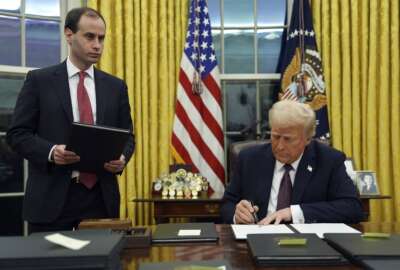Analysis: How to define ‘inherently governmental’
Francis Rose is joined by industry leaders and federal employees in an effort to parse out the lines of distinction.
wfedstaff | June 3, 2015 1:51 pm
By Vyomika Jairam
Federal News Radio
What is the business that the government should do? And what is the business that the government MUST do? That is one of the key questions in defining what is “inherently governmental” and was the focus of Federal News Radio’s latest In Depth Conversation with Francis Rose.
Joining Francis Rose were Barbara Atkin, Deputy General Counsel, National Treasury Employees Union; Angela Styles, Partner, Crowell & Moring and author of OMB Circular A-76; and Al Burman, President, Jefferson Solutions and a former administrator at the Office of Federal Procurement Policy.
Burman was responsible in 1992 for writing the original memo defining what was “inherently governmental.” The idea then, he said, was to address the concerns by members of Congress on whether or not agencies were actually doing their own business or were relying too much on the private sector. Were contractors doing jobs that really should be done by public servants?
The issue was a recurring one, Burman said.
Atkin said not much has changed since then. As general counsel of the NTEU, she has seen the private sector funding rise and with it the number of federal contractors to more than seven million, which is more than four times the size of the federal workforce.
So what are the issues at stake?
According to Burman, the questions are basic and haven’t changed much when evaluating the work that private contractors carry out.
- Can you ensure that the public interest is being served, and that there aren’t other interests that are coming into play?
- Can you ensure that the government has sufficient oversight and control to get the results they’re looking for?
- And, is there some variance based on the abilities that the government and private entities have that makes one more cost effective?
One major factor in all of this? Regulation. And Congress’s actions don’t always help clarify the situation.
“Congressional micro-management just isn’t good. I don’t know that they can always understand an agency, and how an agency might be able to formulate something too effectively,” Styles said. “The more Congress micro-manages, the less flexibility the agency is going to have. In making that decision, an agency needs flexibility to decide what the private sector can do, what can the public sector do.”
Styles, the author of OMB Circular A-76, detailing the Bush Administration’s competitive sourcing initiative, was responsible for looking into how the private sector’s role played out in those years. Her take was that Congress can both help spur change in the arena but that adding oversight might now be the way to go.
“That can lead to an unsuccessful program when people in Congress decide how a particular agency should be managed,” Styles said.
The bigger question, Styles said, should be how can you use what the private sector does well and bring it into the public space?
Burman added that the government shouldn’t be in the business of being in competition with the commercial activities of the private sector.
Questions that should be asked, he says:
- What is being done? Is it commercial?
- Is it something that is out there in the private sector?
- Does the private sector do it well?
“You want the government to reserve its responsibilities for things that the government should do and not necessarily to compete with those people that do these other works,” Burman said.
Copyright © 2025 Federal News Network. All rights reserved. This website is not intended for users located within the European Economic Area.





